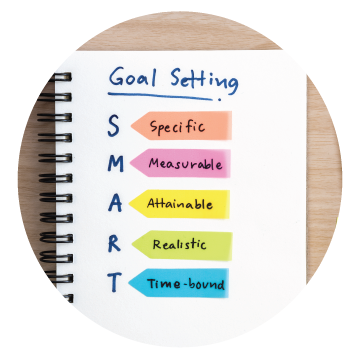Key to Success – Setting S.M.A.R.T. Goals

One of the greatest keys to success, in both your personal and professional life, is effective goal setting; and the way in which you express a goal can have a significant influence on your likelihood of achieving it.
One of LMA’s key principles of effective goal setting is that your goals must be S.M.A.R.T. goals.
S.M.A.R.T. is an acronym for the five qualities of an effective goal. A S.M.A.R.T. goal is Specific, Measurable, Attainable, Realistic and Tangible. If you ensure that you set S.M.A.R.T. goals it will better enable you to devise specific Action Steps for the achievement of those goals.
S stands for SPECIFIC. One of the most important qualities of an effective goal is that it’s specific. A specific goal clearly defines exactly what you want to accomplish, and therefore has a much greater chance of being accomplished than a vague goal.
To set a specific goal, ask yourself:
- WHO? List who is involved
- WHAT? Determine what you want to accomplish
- WHERE? Identify a location
- WHEN? Establish a time frame
- WHICH? Identify requirements and constraints
- WHY? Specify the reasons or purpose and the benefits of accomplishing the goal
One simple action you can take to make your goals more specific is to write them down. By writing them down in “black and white”, you will see more clearly where your goal is specific and where it isn’t.
M stands for MEASURABLE. A goal is measurable when it can be quantified. Establish concrete criteria and a process for measuring your progress toward the attainment of each goal you set.
To determine if your goal is measurable, ask questions such as:
- “How much?”
- “How many?”
- “How will I know when it is accomplished?”
- “What methods of measurement will I use?”
When you measure your progress, you stay on track, reach your target dates and experience the exhilaration of achievement that spurs you on to continued improvement and ongoing success.
A stands for ATTAINABLE. A goal is attainable when it is humanly possible to accomplish. When you identify the goals that are most important to you, you begin to find ways to make them come true. You begin seeing previously overlooked opportunities to bring yourself closer to the achievement of your goals and you develop the abilities, skills and financial capability to reach them.
You can attain most of the goals you set when you plan your steps wisely and establish a time frame that allows you to carry out those steps. Goals that may have seemed out of reach eventually move closer and become attainable, not because your goals shrink, but because you grow and expand to match them. When you list your goals, you build your self-image, you see yourself as worthy of these goals and you develop the traits and personality that allow you to possess them.
R stands for REALISTIC. A goal is realistic when it represents an objective toward which you are both willing and able to work towards. Realistic is relative to each person based on their own situation at a given point in time. If you rarely exercise it would be an unrealistic goal to complete a marathon this weekend.
A goal is realistic when you truly believe that it can be accomplished with the time and resources available to you. One way to know if your goal is realistic is to determine if you have accomplished anything similar in the past. Another way to help you determine if a goal is realistic is to ask yourself what conditions would have to exist to accomplish this goal.
A goal can be both high and realistic. You are the only one who can decide just how high your goal should be, but be sure that every goal represents substantial progress. A high goal is frequently easier to reach than a low one because a low goal exerts a low motivational force. Some of the hardest jobs you ever accomplished actually seemed easy, simply because they were a labour of love and motivated you. So, if you love to run, perhaps a more realistic goal is to complete a half-marathon in three months time… and so on.
T stands for TANGIBLE. A goal is tangible when you can experience it with one of the senses: taste, touch, smell, sight or hearing. In other words, you must be able to feel and sense what it will be like when your goal is accomplished.
When you make your goal specific, you’re usually able to “see it.” But to truly make your goal tangible, you must add one or more of the other senses. Then you’ll actually be able to experience it “in advance”, giving yourself sufficient “pull” to help overcome present road blocks or behaviour patterns.
When your goal is tangible, or when you tie an intangible goal to a tangible, you have a better chance of making it specific and measurable and thus attainable.
Intangible goals are your goals for the internal changes required to reach more tangible goals. They are the personality characteristics and the behaviour patterns you must develop to pave the way to success and the achievement of your other goals. Since intangible goals are vital for improving your effectiveness, give close attention to tangible ways of measuring them. Ask yourself “What evidence of accomplishment will there be when I reach this goal?”
If you are interested in knowing more about this and other keys to success that will dramatically improve your leadership, productivity, and performance, contact LMA today.





